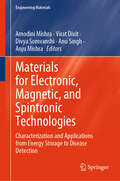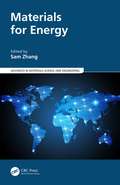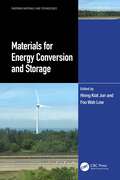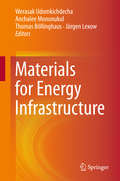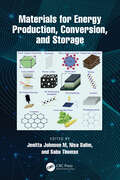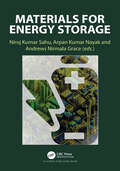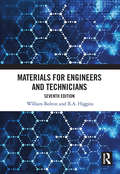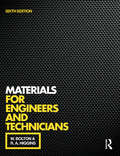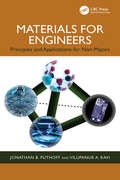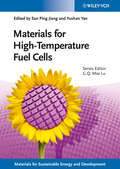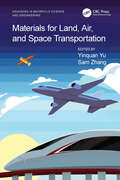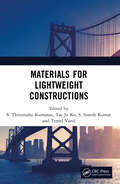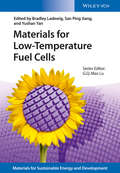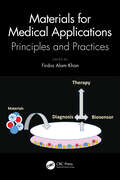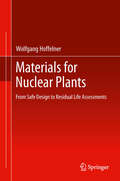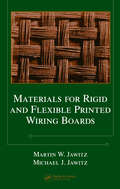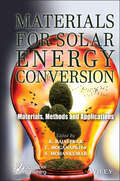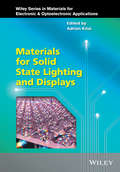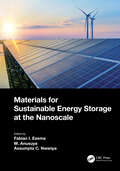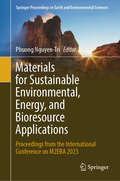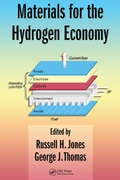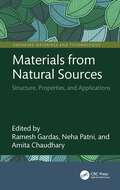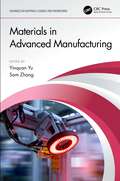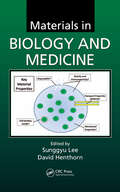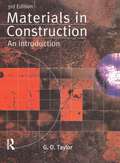- Table View
- List View
Materials for Electronic, Magnetic, and Spintronic Technologies: Characterization and Applications from Energy Storage to Disease Detection (Engineering Materials)
by Amodini Mishra Virat Dixit Divya Somvanshi Anu Singh Anju MishraThis book consolidates the collective contributions of various authors, presenting a diverse array of materials for systematic property assessment and their subsequent application in electronic, magnetic, and spintronic technologies. Encompassing pure and modified polymers, metals, and semiconductors, the book elucidates the magnetic, photocatalytic, thermal, electrochemical, and other salient characteristics inherent in these materials. Delving into a broad spectrum of applications such as energy storage, environmental remediation (water purification), and biomedical (drug administration), the book carefully examines these materials in the context of their distinctive attributes. By elucidating the correlation between a material's functionality and its physical properties, this work offers a lucid and accessible presentation that facilitates an understanding of how these materials can be judiciously employed for specific purposes. Designed for researchers, graduate students, educators, engineers, industry researchers, and other informed members of the public, the comprehensive coverage of this book renders it an indispensable tool in the realm of materials science and technology. Through its meticulous exploration of various materials and their applications, this work stands as a valuable resource for those seeking a profound understanding of the intricate interplay between material properties and their functionalities.
Materials for Energy (Advances in Materials Science and Engineering)
by Sam ZhangMaterials for Energy offers a comprehensive overview of the latest developments in materials for efficient and sustainable energy applications, including energy conversion, storage, and smart applications. Discusses a wide range of material types, such as nanomaterials, carbonaceous electrocatalysts and electrolytes, thin films, phase change materials, 2D energy materials, triboelectric materials, and membrane materials Describes applications that include flexible energy storage devices, sensors, energy storage batteries, fuel and solar cells, photocatalytic wastewater treatment, and more Highlights current developments in energy conversion, storage, and applications from a materials angle Aimed at researchers, engineers, and technologists working to solve alternative energy issues, this work illustrates the state of the art and latest technologies in this important field.
Materials for Energy Conversion and Storage (Emerging Materials and Technologies)
by Hieng Kiat Jun Foo Wah LowDevelopment of new energy‑related materials is essential in addressing future energy demands. Materials for Energy Conversion and Storage focuses on the materials science related to energy conversion and energy storage technologies. It covers the principles of prospective energy technologies and their relationship to the performance of energy devices.• Covers fundamental principles of energy conversion and storage• Discusses materials selection, design, and performance tradeoffs• Details electrochemical cell construction and testing methodologies• Explores sustainable development of energy devices• Features case studiesAimed at readers in materials, electrical, and energy engineering, this book provides readers with a deep understanding of the role of materials in developing sustainable energy devices.
Materials for Energy Infrastructure
by Werasak Udomkichdecha Anchalee Mononukul Thomas Böllinghaus Jürgen LexowThis book presents contributions to the topics of materials for energy infrastructure with a focus on data and informatics for materials. This spectrum of topics has been chosen because challenges in terms of materials are identified to lie in transport and storage of energy, adequate supply of food and water, well-working infrastructure, materials for medical application and health, efficient use of scarce resources or elements and alternate materials solutions as well as recycling. The contributions were invited at the 4th WMRIF Young Materials Scientist Workshop held at the National Institute for Standards and Technology (NIST) in Boulder, Colorado, USA during September 8-10, 2014.
Materials for Energy Production, Conversion, and Storage
by Sabu Thomas Nisa Salim M Jenitta JohnsonThis volume provides a comprehensive review of energy production, management, and its challenges pertaining to various materials. It covers different material fabrication strategies involved in the processes such as laser-assisted fabrication, electrospinning strategy, and so forth, including a review of the different nanostructured materials and challenges in energy management. Factors affecting energy storage and conversion focussing on high entropy and phase change-based materials are covered. The concepts in the book are supported by illustrations and case studies.Features: Covers different fabrication strategies for various energy materials. Focusses on emerging materials such as MXenes, aerogels, and so forth. Provides a detailed study of laser-assisted fabrication, electrospinning strategy, and 3D-printed materials. Includes a comprehensive study of energy management from biomass. Reviews current strategies for electronic waste management. This book is aimed at researchers and graduate students in chemical engineering, electrochemistry, and materials science.
Materials for Energy Storage
by Andrews Nirmala Grace Niroj Kumar Sahu Arpan Kumar NayakMaterials for Energy Storage offers a combinatorial understanding of materials science and electrochemistry in electrochemical energy storage devices with a holistic overview of the status, research gaps, and future opportunities. Rooted in a profound understanding of contemporary energy utilization, aligned with the sustainable development goals, this book delves deep into the several device chemistries, impact of nanomaterials, and critical factors related to the device performance. It discusses electrode-electrolyte interaction, device fabrication, and commercial aspects. This book will offer value to the graduate and postgraduate students, researchers, and industry professionals related to materials science and energy technology.
Materials for Engineers and Technicians
by William Bolton R.A. HigginsFor over forty years, Materials for Engineers and Technicians has given thousands of students an easily accessible introduction to materials engineering and manufacturing processes. This renowned text is a comprehensive overview of the wide-ranging subject area, written in a straightforward, readable style. It is devoid of excessive jargon and mathematical complexity, and retains a practical down-to-earth approach. This expanded edition references specifications for materials and materials testing that have been updated to include European-wide standards of the EU. More applications of materials and case studies have been included. New content discusses the choice of materials and processes in relation to 3D printing and the importance of materials recycling and sustainability. The increased emphasis on the selection of materials reflects this aspect of materials engineering now seen within current vocational and university courses. In addition to meeting the requirements of vocational and undergraduate engineering syllabuses, this text also serves as a valuable desktop reference for professional engineers working in product design who require a quick source of information on materials and manufacturing processes.
Materials for Engineers and Technicians, 6th ed
by W. Bolton R. A. HigginsA comprehensive yet accessible introduction to materials engineering which provides a straightforward, readable approach to the subject. The sixth edition includes a new chapter on the selection of materials, an updated discussion of new materials, and a complete glossary of key terms used in materials engineering. This renowned text has provided many thousands of students with an easily accessible introduction to the wide ranging subject area of materials engineering and manufacturing processes for over forty years. It avoids the excessive jargon and mathematical complexity so often found in textbooks for this subject, retaining the practical down-to-earth approach for which the book is noted. The increased emphasis on the selection of materials reflects the increased emphasis on this aspect of materials engineering now seen within current vocational and university courses. In addition to meeting the requirements of vocational and undergraduate engineering syllabuses, this text will also provide a valuable desktop reference for professional engineers working in product design who require a quick source of information on materials and manufacturing processes.
Materials for Engineers: Principles and Applications for Non-Majors
by Jonathan B. Puthoff Vilupanur A. RaviA working understanding of materials principles is essential in every area of engineering. However, the materials requirements of different engineering disciplines can vary considerably. Existing introductory textbooks on engineering materials adopt a universalist approach, providing theoretical development and surveying a landscape of topics suitable for introducing materials engineers to their field. Materials for Engineers: Principles and Applications for Non-Majors has been constructed with the requirements of non-materials engineering students (“non-majors") in mind. The theoretical foundations of material structure and behavior are curated and focused, and the description of the behavior of materials as they pertain to performance, measurement, and design are developed in detail.The book: Places applications and essential measurement methods before detailed theory Features a variety of types end-of-chapter exercises, including forum discussion topics for online course components Emphasizes computer-based problem solving and includes numerous examples and exercises for MATLAB® Includes optional “topic” chapters for course customization, including structures, transportation, and electronics Outlines practical details of how and why knowledge of materials is necessary for engineers, including the various roles that materials engineers play and the impact of materials on cost, lifespan, and safety of components and products This textbook is aimed at undergraduate engineering students taking their first materials engineering course. It can also be used by professional engineers interested in a ready reference. A solutions manual, lecture slides, and example data sets are available for adopting professors.
Materials for High-Temperature Fuel Cells
by San Ping Jiang Max Lu Yushan YanThe world's ever-growing demand for power has created an urgent need for new efficient and sustainable sources of energy and electricity. Today's consumers of portable electronics also demand devices that not only deliver more power but are also environmentally friendly. Fuel cells are an important alternative energy source, with promise in military, commercial and industrial applications, for example power vehicles and portable devices.A fuel cell is an electrochemical device that directly converts the chemical energy of a fuel into electrical energy. Fuel cells represent the most efficient energy conversion technologies to-date and are an integral part in the new and renewable energy chain (e.g., solar, wind and hydropower). Fuel cells can be classified as either high-temperature or lowtemperature, depending on their operating temperature, and have different materials requirements. This book is dedicated to the study of high temperature fuel cells. In hightemperature fuel cells, the electrolyte materials are ceramic or molten carbonate, while the electrode materials are ceramic or metal (but not precious metal). High operation temperature fuel cells allow internal reforming, promote rapid kinetics with non-precious materials and offer high flexibilities in fuel choice, and are potential and viable candidate to moderate the fast increase in power requirements and to minimize the impact of theincreased power consumption on the environment.'Materials for High Temperature Fuel Cells' is part of the series on Materials for Sustainable Energy and Development edited by Prof. Max Q. Lu. The series covers advances in materials science and innovation for renewable energy, clean use of fossil energy, and greenhouse gas mitigation and associated environmental technologies.
Materials for Land, Air, and Space Transportation (Advances in Materials Science and Engineering)
by Sam Zhang Yinquan YuAs transportation systems for land, air, and space vehicles continue to grow increasingly sophisticated, more advanced materials are needed to support their development and commercialization. Materials for Land, Air, and Space Transportation details new materials development for these transportation applications, emphasizing physical properties, research theories, and cutting-edge processing technologies, as well as advanced high-precision inspection methodologies.• Covers materials, design, and manufacturing for lightweight vehicles, high-speed trains, fuel cell vehicles, and aerospace and aeronautical use.• Focuses on the newest material function and processing technologies, covering nanotechnology, modern additive manufacturing techniques, and physical and mechanical studies of structure-sensitive properties of materials.• Describes theoretical deduction, numerical simulation, and experimental studies of various materials.This reference will be of interest to engineers and researchers in the disciplines of materials, mechanical, and transportation engineering, and related areas.
Materials for Lightweight Constructions
by S. Thirumalai Kumaran Tae Jo Ko S. Suresh Kumar Temel VarolThis book presents the key concepts and methods involved in the development of a variety of materials for lightweight constructions, including metals, alloys, polymers and composites. It provides case studies and examples to explain strategies adapted for specific applications of the materials and covers traditional to advanced manufacturing concepts of lightweight materials, including 3D printing. It also illustrates the fundamentals and usability of biodegradable materials for achieving a greener environment, as well as possibilities of green manufacturing. Covers the fundamentals of a range of materials used for lightweight constructions Discusses fabrication and testing of materials Addresses relevant concepts of 3D printing and biodegradable materials Explores analysis of the failure mechanism of materials used in various applications Identifies the applicability of materials to a variety of situations Materials for Lightweight Constructions will suit researchers and graduate students in materials science, mechanical engineering, construction and composites.
Materials for Low-Temperature Fuel Cells
by San Ping Jiang Max Lu Yushan Yan Bradley LadewigThere are a large number of books available on fuel cells; however, the majority are on specific types of fuel cells such as solid oxide fuel cells, proton exchange membrane fuel cells, or on specific technical aspects of fuel cells, e.g., the system or stack engineering. Thus, there is a need for a book focused on materials requirements in fuel cells. Key Materials in Low-Temperature Fuel Cells is a concise source of the most important and key materials and catalysts in low-temperature fuel cells. A related book will cover key materials in high-temperature fuel cells. The two books form part of the "Materials for Sustainable Energy & Development" series.Key Materials in Low-Temperature Fuel Cells brings together world leaders and experts in this field and provides a lucid description of the materials assessment of fuel cell technologies. With an emphasis on the technical development and applications of key materials in low-temperature fuel cells, this text covers fundamental principles, advancement, challenges, and important current research themes. Topics covered include: proton exchange membrane fuel cells, direct methanol and ethanol fuel cells, microfluidic fuel cells, biofuel cells, alkaline membrane fuel cells, functionalized carbon nanotubes as catalyst supports, nanostructured Pt catalysts, non-PGM catalysts, membranes, and materials modeling.This book is an essential reference source for researchers, engineers and technicians in academia, research institutes and industry working in the fields of fuel cells, energy materials, electrochemistry and materials science and engineering.
Materials for Medical Applications: Principles and Practices
by Firdos Alam KhanThis book discusses advanced knowledge about the synthesis and application of materials in the medical field for diagnostic and therapeutic conditions. These materials have been extensively used in various biological and medical applications, especially in drug delivery, tumor screening, bioimaging, diagnosis, and therapies. Materials for Medical Applications provides comprehensive but concise information about materials and their medical applications. The readers will get information about the trends in materials and their medical applications, as well as current material-based products that are used in the medical field. The book has 11 chapters, where shapes, sizes, and structural differences of materials and methods of synthesis have been described, and a few chapters are also dedicated to the characterization of materials and their medical applications. The book also discusses how materials are tested in research laboratories, preclinical (animal) trials, and clinical (human) trials, and how material-based products go through various regulatory and safety phases before reaching patients. It also discusses topics such as materials delivery, imaging, and treatments for various diseases. It includes a chapter dedicated to regulatory guidelines and policies in the application of nanomaterials and will include current clinical trial information on the materials. Finally, the book has topics such as health safety, toxicity, dosages, and long-term implications of materials. This book is intended for researchers, material scientists, and students in bioengineering, biomedical engineering, and biopharmaceuticals working on the development of biomaterials.
Materials for Nuclear Plants
by Wolfgang HoffelnerThe clamor for non-carbon dioxide emitting energy production has directly impacted on the development of nuclear energy. As new nuclear plants are built, plans and designs are continually being developed to manage the range of challenging requirement and problems that nuclear plants face especially when managing the greatly increased operating temperatures, irradiation doses and extended design life spans. Materials for Nuclear Plants: From Safe Design to Residual Life Assessments provides a comprehensive treatment of the structural materials for nuclear power plants with emphasis on advanced design concepts. Materials for Nuclear Plants: From Safe Design to Residual Life Assessments approaches structural materials with a systemic approach. Important components and materials currently in use as well as those which can be considered in future designs are detailed, whilst the damage mechanisms responsible for plant ageing are discussed and explained. Methodologies for materials characterization, materials modeling and advanced materials testing will be described including design code considerations and non-destructive evaluation concepts. Including models for simple system dynamic problems and knowledge of current nuclear power plants in operation, Materials for Nuclear Plants: From Safe Design to Residual Life Assessments is ideal for students studying postgraduate courses in Nuclear Engineering. Designers on courses for code development, such as ASME or ISO and nuclear authorities will also find this a useful reference.
Materials for Rigid and Flexible Printed Wiring Boards (Electrical and Computer Engineering #131)
by Martin W. Jawitz Michael J. JawitzComplex electronic circuits and devices are flooding applications in nearly every facet of commercial and industrial activity, from automated equipment to all types of consumer products. Proper selection of materials is crucial to meet the end-use requirements of flexible and rigid printed wiring boards. While there are many useful books and articles on the fabrication of printed circuit boards, Materials for Rigid and Flexible Printed Wiring Boards is the first book to detail the properties of the materials used and how they are made.The authors present important manufacturing information and material properties for reinforcement materials, resins, flexible films, copper foils, rigid laminates, high-speed/high-frequency laminates, and metal core and constraining core materials. They offer practical guidance to help designers, engineers, and fabricators choose suitable materials to successfully meet strength, weight, thickness, performance, cost, and other requirements. In most cases, the material data comes directly from manufacturers' data sheets, representing typical values. The book illustrates the comparative strengths and limitations of the materials, highlights their basic properties, and details the manufacturing processes used to make them.Offering practical guidance based on years of experience, Materials for Rigid and Flexible Printed Wiring Boards is a one-stop source of crucial information for anyone designing or building printed circuit boards for any application.
Materials for Solar Energy Conversion: Materials, Methods and Applications
by R. Rajasekar C. Moganapriya A. MohankumarMATERIALS FOR SOLAR ENERGY CONVERSION This book provides professionals and students with a resource on the basic principles and applications of solar energy materials and processes, as well as practicing engineers who want to understand how functional materials operate in solar energy conversion systems. The demand for energy is increasing daily, and the development of sustainable power generation is a critical issue. In order to overcome the energy demand, power generation through solar energy is booming. Many research works have attempted to enhance the efficiency of collection and storage of solar energy and, as a result, numerous advanced functional materials have been developed for enhancing the performance of solar cells. This book has compiled and broadly explores the latest developments of materials, methods, and applications of solar energy. The book is divided into 2 parts, in which the first part deals with solar cell fundamentals and emerging categories, and the latter part deals with materials, methods, and applications in order to fill the gap between existing technologies and practical requirements. The book presents detailed chapters including organic, inorganic, coating materials, and collectors. The use of modern computer simulation techniques, conversion and storage processes are effectively covered. Topics such as nanostructured solar cells, battery materials, etc. are included in this book as well. Audience The book is aimed at researchers in materials science, chemistry, physics, electrical and mechanical engineering working in the fields of nanotechnology, photovoltaic device technology, and solar energy.
Materials for Solid State Lighting and Displays
by Adrian KitaiLEDs are in the midst of revolutionizing the lighting industry Up-to-date and comprehensive coverage of light-emitting materials and devices used in solid state lighting and displays Presents the fundamental principles underlying luminescence Includes inorganic and organic materials and devices LEDs offer high efficiency, long life and mercury free lighting solutions
Materials for Sustainable Energy Storage at the Nanoscale
by Fabian I. Ezema M. Anusuya Assumpta C. NwanyaThe book Materials for Sustainable Energy Storage Devices at the Nanoscale anticipates covering all electrochemical energy storage devices such as supercapacitors, lithium-ion batteries (LIBs), and fuel cells,transformation and enhancement materials for solar cells, photocatalysis, etc. The focal objective ofthe book is to deliver stunning and current information to the materials application at nanoscale toresearchers and scientists in our contemporary time towardthe enhancement of energy conversion andstorage devices. However, the contents of the proposed book, Materials for Sustainable Energy Storageat the Nanoscale, will cover various fundamental principles and wide knowledge of different energyconversion and storage devices with respect to their advancement due to the emergence of nanoscalematerials for sustainable storage devices. This book is targeted to be award-winning as well as a referencebook for researchers and scientists working on different types of nanoscale materials-based energystorage and conversion devices. Features Comprehensive overview of energy storage devices, an important field of interest for researchers worldwide Explores the importance and growing impact of batteries and supercapacitors Emphasizes the fundamental theories, electrochemical mechanism, and its computational viewpoint and discusses recent developments in electrode designing based on nanomaterials, separators,and fabrication of advanced devices and their performances Fabian I. Ezema is a professor at the University of Nigeria, Nsukka. He earned a PhD in Physics and Astronomy from the University of Nigeria, Nsukka. His research focused on several areas of Materials Science, from synthesis and characterizations of particles and thin-film materials through chemical routes with emphasis on energy applications. For the last 15 years, he has been working on energy conversion and storage (cathodes, anodes, supercapacitors, solar cells, among others), including novel methods of synthesis, characterization and evaluation of the electrochemical and optical properties. He has published about 180 papers in various international journals and given over 50 talks at various conferences. His h-index is 21 with over 1500 citations and he has served as reviewer for several high impact journals and as an editorial board member. Dr. M.Anusuya, M.Sc., M.Phil., B.Ed., PhD is specialized in Material science, Thin Film Technology, Nano Science, and Crystallography. She is working as a Registrar of Indra Ganesan Group of Institutions, Trichy, Tamilnadu, India. Earlier to this, she served as a Vice-Principal at Trichy Engineering College, Trichy, Tamilnadu, India.. Being an administrator and teacher, with more than 25 years’ experience, for her perpetual excellence in academics she has been recognized with many awards. She has received over 45 awards in Academic and Social Activity. She has published more than 30 research papers in National and International journals, 7 chapters in edited books, 5 patents, presented 50 papers in the conferences and organized more than 200 webinars, both national and internationally. Dr Assumpta C. Nwanya is a Lecturer and a FLAIR (Future Leaders - African Independent Research) Scholar at the Department of Physics and Astronomy, University of Nigeria, Nsukka. She obtained her PhD in 2017 (University of Nigeria, Nsukka) with specialisation in the synthesis of nanostructured materials for applications in photovoltaics and electrochemical energy storage (batteries and supercapacitors) as well as for sensing. She was a Postdoctoral Fellow under the UNESCO-University of South Africa (UNISA) Africa Chair in Nanoscience and Nanotechnology (2018-2020). She is a research Affiliate with the SensorLab, University of the Western Cape Sensor Laboratories, Cape Town, South Africa. Dr Nw
Materials for Sustainable Environmental, Energy, and Bioresource Applications: Proceedings from the International Conference on M2EBA 2023 (Springer Proceedings in Earth and Environmental Sciences)
by Phuong Nguyen-TriThis proceedings book showcases the latest research and developments in materials sciences and their applications for solving environmental and energy-related challenges. The book features insightful contributions from leading researchers, academics, professionals, and students in the field, who share their expertise, experiences, and perspectives on the key issues and innovations in materials sciences and engineering. The book is helpful to those interested in environmental sustainability, energy efficiency, or bioresource utilization.
Materials for the Hydrogen Economy
by Russell H. Jones George J. ThomasHydrogen offers a promising alternative for supplying clean and sustainable energy to meet increasing demands worldwide. However, materials are key to transforming the technology into a viable industry. Materials for the Hydrogen Economy describes the technical challenges and the current efforts in developing materials possessing the properties req
Materials from Natural Sources: Structure, Properties, and Applications (Emerging Materials and Technologies)
by Amita Chaudhary Ramesh Gardas Neha PatniThis book comprises interdisciplinary topics including consolidating research activities in all experimental and theoretical aspects of natural advanced materials in the fields of science, engineering, and medicine including structure, synthesis, processing, physico-chemical properties, and applications.The book covers formulation for natural and organic cosmetics, CO2 sequestration, drug delivery systems, biosensors, and other related topics. In addition, case studies including some data are presented that demonstrate the growing interest and cost benefits of biomaterials.The main features of the book are: It discusses the properties and applications of materials from natural sources from an environmental and biomedical engineering perspective. It explores properties of natural materials used in drug delivery, biofuel, adsorbents, waste water treatment, cosmetics, and so forth. It includes studies on recent and emerging biomaterials. It details applications of natural materials in varied areas. It introduces the structure and mechanisms of self-healing material, biomaterial, biofuel, polymers, and adsorbents. This book is aimed at graduate students and researchers in chemical, environmental, and natural resource engineering.
Materials in Advanced Manufacturing (Advances in Materials Science and Engineering)
by Sam Zhang Yinquan YuThis book introduces the latest processing technologies for a variety of materials in advanced manufacturing and applications. Design criteria and considerations of processing or devices are theoretically introduced, and numerical simulation and experimental study are included. FEATURES Covers a variety of materials, including hard materials, soft materials, metals, and composites Describes nanotechnology approaches, modern piezoelectric techniques, and physical and mechanical studies of the structure-sensitive properties of the materials Reviews advanced manufacturing for antenna applications and embroidered RFID tags for wearable applications Considers additive manufacturing of cellular solids and metal additive manufacturing Discusses advanced materials for sound absorption Aimed at engineers, researchers, and advanced students in materials processing and advanced manufacturing, this work helps readers to understand which processing technology is suitable for a specific material and the design rules for a particular application.
Materials in Biology and Medicine (Green Chemistry and Chemical Engineering)
by Sunggyu Lee David HenthornWhile the interdisciplinary field of materials science and engineering is relatively new, remarkable developments in materials have emerged for biological and medical applications, from biocompatible polymers in medical devices to the use of carbon nanotubes as drug delivery vehicles. With peer-reviewed chapters written by a select group of academic and industry experts, this comprehensive yet accessible book covers the most advanced materials used in biology and medicine. The book focuses on biomaterials and bioinspired materials, functional and responsive materials, controlling biology with materials, and the development of devices and enabling technologies. It will help readers tackle challenges of novel materials, carry out new process and product development projects, and create new methodologies for applications that enhance the quality of life.
Materials in Construction: An Introduction (Chartered Institute Of Building Ser.)
by G. D. TaylorMaterials in Construction: An Introduction presents a clear and accessible introduction to the principles, practice and performance of construction materials. This new edition is being published as a companion to G. D. Taylor's Materials in Construction: Principles, Practice and Performance - an advanced text that will develop the topics presented in this book. The coverage of a wide range of construction materials provides a comprehensive foundation to the subject, and includes an overview of performance characteristics and standards for many materials. The text also reviews material properties, and examines and evaluates modes of deterioration while emphasising preventative techniques and remedial treatment. Throughout the text carefully devised example experiments and questions support the theory and practical information. Materials in Construction is an essential handbook for any student studying materials as part of a construction course at BTEC NC/D, HNC/D and undergraduate level.
